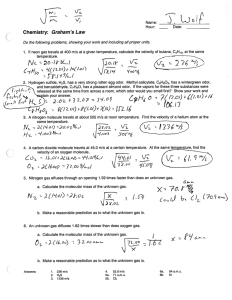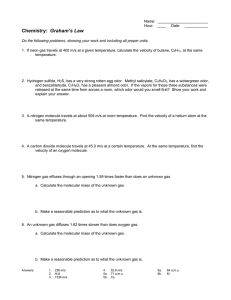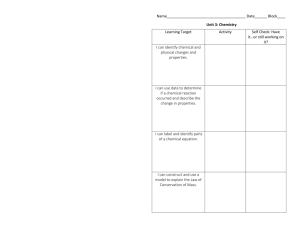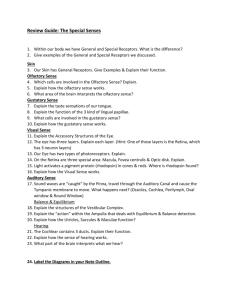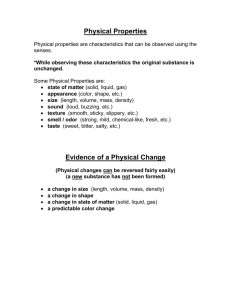Perceptual and Neural Pliability of Odor Objects
advertisement
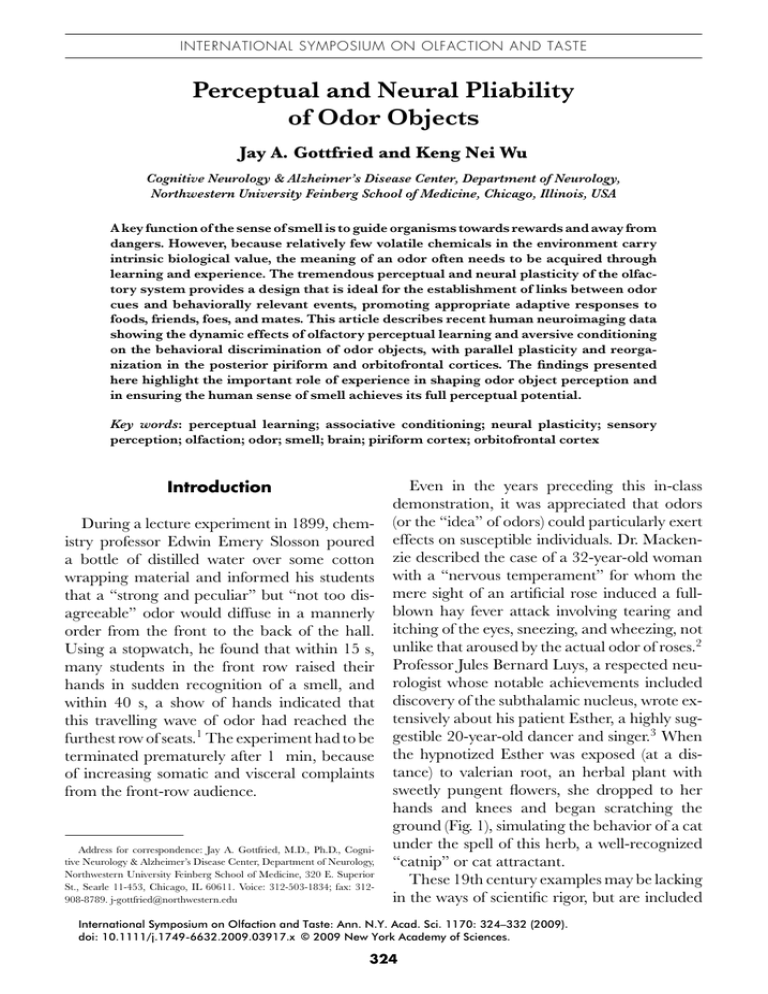
INTERNATIONAL SYMPOSIUM ON OLFACTION AND TASTE Perceptual and Neural Pliability of Odor Objects Jay A. Gottfried and Keng Nei Wu Cognitive Neurology & Alzheimer’s Disease Center, Department of Neurology, Northwestern University Feinberg School of Medicine, Chicago, Illinois, USA A key function of the sense of smell is to guide organisms towards rewards and away from dangers. However, because relatively few volatile chemicals in the environment carry intrinsic biological value, the meaning of an odor often needs to be acquired through learning and experience. The tremendous perceptual and neural plasticity of the olfactory system provides a design that is ideal for the establishment of links between odor cues and behaviorally relevant events, promoting appropriate adaptive responses to foods, friends, foes, and mates. This article describes recent human neuroimaging data showing the dynamic effects of olfactory perceptual learning and aversive conditioning on the behavioral discrimination of odor objects, with parallel plasticity and reorganization in the posterior piriform and orbitofrontal cortices. The findings presented here highlight the important role of experience in shaping odor object perception and in ensuring the human sense of smell achieves its full perceptual potential. Key words: perceptual learning; associative conditioning; neural plasticity; sensory perception; olfaction; odor; smell; brain; piriform cortex; orbitofrontal cortex Introduction During a lecture experiment in 1899, chemistry professor Edwin Emery Slosson poured a bottle of distilled water over some cotton wrapping material and informed his students that a “strong and peculiar” but “not too disagreeable” odor would diffuse in a mannerly order from the front to the back of the hall. Using a stopwatch, he found that within 15 s, many students in the front row raised their hands in sudden recognition of a smell, and within 40 s, a show of hands indicated that this travelling wave of odor had reached the furthest row of seats.1 The experiment had to be terminated prematurely after 1 min, because of increasing somatic and visceral complaints from the front-row audience. Address for correspondence: Jay A. Gottfried, M.D., Ph.D., Cognitive Neurology & Alzheimer’s Disease Center, Department of Neurology, Northwestern University Feinberg School of Medicine, 320 E. Superior St., Searle 11-453, Chicago, IL 60611. Voice: 312-503-1834; fax: 312908-8789. j-gottfried@northwestern.edu Even in the years preceding this in-class demonstration, it was appreciated that odors (or the “idea” of odors) could particularly exert effects on susceptible individuals. Dr. Mackenzie described the case of a 32-year-old woman with a “nervous temperament” for whom the mere sight of an artificial rose induced a fullblown hay fever attack involving tearing and itching of the eyes, sneezing, and wheezing, not unlike that aroused by the actual odor of roses.2 Professor Jules Bernard Luys, a respected neurologist whose notable achievements included discovery of the subthalamic nucleus, wrote extensively about his patient Esther, a highly suggestible 20-year-old dancer and singer.3 When the hypnotized Esther was exposed (at a distance) to valerian root, an herbal plant with sweetly pungent flowers, she dropped to her hands and knees and began scratching the ground (Fig. 1), simulating the behavior of a cat under the spell of this herb, a well-recognized “catnip” or cat attractant. These 19th century examples may be lacking in the ways of scientific rigor, but are included International Symposium on Olfaction and Taste: Ann. N.Y. Acad. Sci. 1170: 324–332 (2009). c 2009 New York Academy of Sciences. doi: 10.1111/j.1749-6632.2009.03917.x 324 Gottfried & Wu: Olfactory Perceptual Plasticity in the Human Brain 325 Figure 1. Esther, the patient studied by Professor Jules Bernard Luys, as part of his investigations into the neurological basis of hysteria. These photogravures taken in the year 1886 show Esther (A) in the normal state (“à l’état normal”), and (B) hypnotized while under the influence of valerian extract, showing a tendency to scratch the ground (“à gratter la terre”) like a cat driven to frenzy with catnip herbs. In Part B, Esther is looking down at her hands, and the crown of her head is at the center of the photograph. Images reproduced from Luys, 1890, Plate 1 (p. 263) and Plate 20 (p. 301). here to illustrate the cognitive (“top-down”) pliability of human olfactory perception, which is the main theme of this brief article. To what extent can cognitive factors alter how an odor is perceived, or whether it is even perceived at all? Contemporary examples from the human olfactory psychophysical literature convincingly show that learning and experience can modulate the human sense of smell. Mere odor exposure is sufficient to enhance olfactory sensitivity for smells that cannot be initially perceived. For example, subjects with specific anosmia for androstenone were able to detect this compound after 6 weeks of daily exposure,4 and similar effects have been described in women systematically exposed to nonsteroidal odorants, such as benzaldehyde.5 Interestingly, threshold gains in androstenone sensitivity at one nostril can be achieved with prior exposure restricted to the opposite nostril,6 suggesting that a central mechanism mediates these changes. The environmental context surrounding an odor also shapes its perception. In one study,7 presentation of a smell was paired with either a positive or negative verbal label on separate trials, for example, violet-leaf odor accompanied by the word “fresh cucumber” or “mildew.” Not surprisingly, subjects rated the same stimulus more or less pleasant depending on the verbal context. More recent behavioral studies incorporating electrophysiological8 and autonomic9 recordings further support these findings, and a neuroimaging experiment identified areas of the orbitofrontal cortex (OFC) and anterior cingulate cortex that were activated during the verbal modulation of odor hedonics.10 Color cues play an important contextual role in both perceived odor intensity11,12 and perceived odor quality, the latter exemplified by the “counterfeit” red wine study in which a white wine was colored with odorless red dye.13 The above examples suggest that nonolfactory sensory and semantic cues modulate 326 the final perceptual outcome of an odor event. It is equally clear that cognitive factors related to learning and experience help guide the acuity of human olfactory perception. For instance, subjects can distinguish the individual components of a binary odor mixture more readily if at least one of the two substances is familiar— reflecting the influence of prior experience on odor discrimination performance.14–16 Psychological research also indicates that emotional associative learning selectively alters the affective properties of an odor. In a series of experiments, Herz and her colleagues found that evaluative conditioning17 between an odor (the conditioned stimulus) and an experimentally induced positive or negative mood state (such as that evoked by an entertaining or frustrating computer game) modulates the hedonic acceptability of that odor, whereby an unpleasant scent becomes more pleasant, and a pleasant scent becomes more unpleasant.18 This systematic transfer of affect from an emotional experience to a neutral odor stimulus has been shown to influence motivation and cognitive performance in both adults and children.19,20 The remainder of this article will consider some of our own recent experiments investigating experience-induced changes in odor object perception in the human brain, with a focus on perceptual learning and aversive (Pavlovian) conditioning. Olfactory Perceptual Learning Perceptual learning refers to an increase in sensory acuity as a consequence of training and experience.21,22 To explore which brain areas help mediate experience-induced behavioral changes in odor perception, Dr. Wen Li and colleagues in our laboratory23 combined functional magnetic resonance imaging (fMRI) techniques with an olfactory habituation paradigm24–26 to test whether prolonged olfactory exposure (as a simple form of perceptual learning) would modify neural repre- Annals of the New York Academy of Sciences sentations of odor quality in areas previously implicated in coding of this perceptual feature, including piriform cortex27,28 and OFC.27,29–32 Subjects smelled four odorants that systematically varied in perceptual quality (floral, minty) and molecular functional group (ketone, alcohol), enabling us to characterize the effects of odor experience on perceptual differentiation between stimuli sharing critical qualitative or molecular attributes.23 We found that as a result of 3.5-min exposure to one of the four odorants, subjects were better able to differentiate between odorants sharing common perceptual and physical attributes. Thus, subjects exposed to a minty ketone became mint “experts,” such that they were better able to tell apart different minty smells, and they simultaneously became ketone experts. The experience-induced changes in odor perception were sustained for at least 24 h with a single 3.5-min exposure period. Examination of the imaging data revealed that the odor-evoked fMRI activity in both posterior piriform cortex and OFC was increased from pre- to postexposure. Notably, on a subject-by-subject basis, the magnitude of learning-induced change in OFC tightly correlated with individual behavioral changes in odor quality differentiation, implying that this brain region is a critical locus for guiding experience-dependent behavioral improvements in odor expertise. The role of OFC in helping to orchestrate olfactory perceptual learning may reflect its highly integrative anatomical organization, involving dense and reciprocal connectivity with limbic emotional brain networks.33 Olfactory Aversive Conditioning Paradigms of associative learning have been previously shown to influence cue-related tuning profiles in sensory-specific cortex. In the auditory domain, instrumental conditioning between a tone of a specific frequency and a bar press for water reward results in a shift in the tonotopic organization of auditory cortex, Gottfried & Wu: Olfactory Perceptual Plasticity in the Human Brain 327 Figure 2. Schematic depicting the principal methodological steps involved in multivariate pattern-based analysis of the olfactory fMRI data-set. These steps include: (1) the use of an independent odor detection (odor localizer) task to identify odor-active voxels in posterior piriform cortex; (2) extraction of the fMRI signal intensity from each of n piriform voxels for each of i trials per condition; (3) assembly of condition-specific voxel vectors of length n, averaged across i trials; and (4) computation of voxel-wise linear spatial correlations between conditions of interest, for example, between the target and chiral CS+ (tgCS+, chCS+), or between the control enantiomers (CS−, chCS−), both at pre- and postconditioning. (Reproduced from Supplementary Fig. S2 in: Li et al., 2008. Science 319 (5871): 1842–1845.) (Supporting Online Material, at http://www.sciencemag.org/cgi/content/full/319/5871/1842/DC1). (In color in Annals online.) with responses centered at the conditioned frequency.34 In the olfactory domain, olfactory conditioning has been shown to enhance 2deoxyglucose uptake specifically for the conditioned odor in rodent olfactory bulb35,36 and anterior olfactory nucleus,37 and both aversive and appetitive odor conditioning can induce spatially distributed changes of electrical activity in rabbit olfactory bulb.38–40 Linster and colleagues have shown that conditioning between one of two perceptually identical odor enantiomers (mirror-image or “chiral” molecules) and liquid food reward improves rodents’ ability to discriminate between the two odorants.41 To explore the impact of associative olfactory learning on perceptual and neural discrimination of predictive odor cues,42 we combined high-resolution fMRI with multivariate (“pattern-based”) statistical analyses43,44 and olfactory psychophysical measurements. Olfactory multivariate fMRI techniques are designed to preserve spatial information at the level of individual voxels (Fig. 2), even when there may be no significant differences in mean activation across a particular region of interest. With these approaches it is now possible to address a new set of research questions not previously testable, centering around the idea that ensemble fMRI activity patterns in the human brain 328 may represent a viable signature (or code) of sensory perception that can be used to decode an individual’s perceptual experience. Importantly, the use of perceptually identical odor enantiomers enabled us to determine whether humans can acquire the ability to distinguish between odorous stimuli that initially smell the same. To this end we utilized two pairs of odor enantiomers that were perceptually identical: (+)-rose oxide and (−)rose oxide, both sharing a “green” smell; and (R)-2-butanol and (S)-2-butanol, both sharing an “oily-vinous” smell. In an olfactory fMRI paradigm of aversive (Pavlovian) conditioning, one of these four odorants (the target conditioned stimulus, or “tgCS+”) was repeatedly paired with an electric shock to the foot (the unconditioned stimulus), individually titrated to be uncomfortable but still tolerable. The chiral counterpart (“chCS+”) was never paired with shock, nor was the control pair of enantiomers (“CS−” and “chCS−”). Behavioral and fMRI data were also collected in pre- and postconditioning sessions, during which time subjects were presented with each of the four odorants, in the absence of reinforcement. The perceptual effect of aversive learning on odor discrimination was assessed using a forced-choice triangular test (Fig. 3A). Prior to conditioning, subjects were at chance (33%) in discriminating between the two CS+ odorants and between the two CS− odorants. However, after conditioning to the tgCS+, there was a statistically significant improvement (P = 0.01) in discrimination accuracy between tgCS+ and chCS+, in the absence of any change between CS− and chCS−. These findings indicate that aversive learning can enhance perceptual discriminability between initially indistinguishable odors, and that these effects are specific for the CS+. In parallel to these effects, we found that the odor-evoked spatial ensemble patterns of fMRI activity in posterior piriform cortex selectively diverged for the CS+ pair (Fig. 3B and C), as indexed by a decline in the spatial linear correlation between these two stimuli.42 In other words, prior to con- Annals of the New York Academy of Sciences ditioning, the piriform spatial patterns evoked by tgCS+ and chCS+ highly overlapped, but after conditioning, these patterns became more distinct, reflecting the enhanced perceptual discrimination between these two stimuli. No such pattern changes were observed for the CS− enantiomers. Taken together, these results indicate that aversive learning induces piriform plasticity with corresponding gains in odor enantiomer discrimination, underscoring the capacity of fear conditioning to update perceptual representation of predictive cues. Such mechanisms would be critical for animals learning how to optimize detection of potentially threatening information, while minimizing responses to related but nonsalient distractors in the environment. That completely indiscriminable sensations can be transformed into discriminable percepts further highlights the great potential acuity of the human olfactory system under adaptive conditions. Olfactory Sensory Deprivation The preceding studies have demonstrated how learning and experience can enhance odor discrimination at the perceptual and neural levels. In new preliminary work, we are beginning to investigate the inverse question: what effect does the lack of experience have on olfactory processing and plasticity in the human brain? In animal models, odor deprivation, by way of naris occlusion, elicits changes throughout the olfactory system,45–48 suggesting that ongoing sensory input is necessary to maintain olfactory sensory specificity. However, there are presently no studies examining these effects in humans. To date we have completed data analysis from one female subject who was admitted to the hospital for 7 days of binaral odor deprivation. She was admitted to the General Clinical Research Center at Northwestern Memorial Hospital, where she underwent 7 consecutive days of odor deprivation. Nostril occlusion was achieved using hypoallergenic surgical tape and Gottfried & Wu: Olfactory Perceptual Plasticity in the Human Brain 329 Figure 3. Learning-induced perceptual and neural discrimination of indiscriminable cues. (A) Three-way forced-choice triangular tests obtained before (“Pre”) and after (“Post”) odorshock learning show that discrimination accuracy selectively improved for the CS+ enantiomer pair, but not for the CS− pair, following aversive conditioning. ∗ P < 0.05. (B) In posterior piriform cortex, the distributed fMRI ensemble activity patterns between the CS+ pair spatially diverged (became less correlated) after conditioning, in comparison to the CS− pair. ∗ P < 0.05. (C) Posterior piriform “distance maps” from one subject illustrate increasing differentiation (increasing distance; darker-colored voxels) between tgCS+ and chCS+ after conditioning, with minimal effect on CS− and chCS− maps. Each square in the grid represents fMRI signal intensity difference from a different piriform voxel. [Note: the white dots inside some of the squares in part C are used to distinguish positive (orange/red) from negative (medium blue/dark blue) distance changes, if viewed in grayscale mode.] (Reproduced and modified from Figures 2 and 3 in: Li et al., 2008. Science 319 (5871): 1842–1845.) (In color in Annals online.) 1 cm strips of nasal packing foam. Advantages of the inpatient hospital setting include the availability of a negative pressure room to prevent odor accumulation, and continual monitoring by the nursing staff in case of a breach in the nasal dressing. The subject was given scent-free hygiene products and provided with a low-flavor diet. The dressing was changed every 4 h while awake, but was removed at night to permit the subject to sleep with her nose completely unobstructed. Olfactory behavioral and fMRI data were collected just prior to deprivation, immediately after deprivation, and at recovery one week later. 330 Annals of the New York Academy of Sciences Following deprivation, the subject showed modest improvements in both odor detection thresholds (from 11 to 12.25 on the Sniffin’ Sticks Test49 ) and identification scores (from 34 to 36 on the UPSIT50 ), whereas her ability to assess odor quality similarity between perceptually related odorants became more variable and less consistent. In turn, multivariate (patternbased) fMRI analysis revealed that in posterior piriform cortex, odor deprivation increased the spatial correlation between qualitatively similar odorants, reflecting a loss of quality coding specificity within this region. These initial results will clearly require replication with a complete cohort of subjects, but are in keeping with the idea that sustained olfactory exposure is critical for maintaining perceptual and neural discriminability of odor objects. Acknowledgments This research is funded by NIH Grant # K08 DC007653 from the National Institute on Deafness and Other Communication Disorders (to J.A.G.), with additional support by NIH Grant # M01 RR00048 from the National Center for Research Resources (to Northwestern University Feinberg School of Medicine). We would like to thank lab members Dr. Wen Li, James Howard, and Nicholas Bowman for their tireless work and enthusiasm, Nathan Sandalow for his contributions to odor deprivation, staff of the Northwestern Memorial Hospital General Clinical Research Center, and Dr. Rachel Herz for putting together a vibrant ISOT 2008 symposium. Conflicts of Interest Conclusion The studies described here illustrate the important point that odor quality perception (i.e., the quality or character of a smell emitted from an odorous object) is a product not only of its underlying chemical composition (“bottomup” input), but also of personal, idiosyncratic experience (“top-down” modulation). The exact same odorant can take on different perceptual properties and elicit different cortical responses, depending on prior memories, current context, and future expectations. Our own data show that an invariant chemical input can evoke different brain responses in posterior piriform cortex and OFC, suggesting that neural representations of odor are not static, predetermined, or predictable, but are flexibly updated by experience.51 Indeed, it is fair to say that the tremendous plasticity of the olfactory system is perhaps its most singular functional characteristic, making possible the dynamic and ubiquitous formation of links between odor cues and behaviorally relevant events, ensuring appropriate, adaptive responses to foods, friends, foes, and mates. The authors declare no conflicts of interest. References 1. Slosson, E.E. 1899. A lecture experiment in hallucinations. Psychol. Rev. 6: 407–408. 2. Mackenzie, J.N. 1886. The production of the socalled “rose cold” by means of an artifical rose, with remarks and historical notes. Am. J. Med. Sci. 91: 45–57. 3. Luys, J. 1890. Les émotions dans l’état d’hypnotisme et l’action a distance des substances médicamenteuses ou toxiques. Librairie J.-B. Baillière et Fils, Paris. 4. Wysocki, C.J., K.M. Dorries & G.K. Beauchamp. 1989. Ability to perceive androstenone can be acquired by ostensibly anosmic people. Proc. Natl. Acad. Sci. USA 86: 7976–7978. 5. Dalton, P., N. Doolittle & P.A. Breslin. 2002. Genderspecific induction of enhanced sensitivity to odors. Nat. Neurosci. 5: 199–200. 6. Mainland, J.D., E.A. Bremner, N. Young, et al. 2002. Olfactory plasticity: one nostril knows what the other learns. Nature 419: 802. 7. Herz, R.S. & J. von Clef. 2001. The influence of verbal labeling on the perception of odors: evidence for olfactory illusions? Perception 30: 381–391. 8. Lundstrom, J.N., S. Seven, M.J. Olsson, et al. 2006. Olfactory event-related potentials reflect individual differences in odor valence perception. Chem. Senses 31: 705–711. Gottfried & Wu: Olfactory Perceptual Plasticity in the Human Brain 9. Djordjevic, J., J.N. Lundstrom, F. Clement, et al. 2008. A rose by any other name: would it smell as sweet? J. Neurophysiol. 99: 386–393. 10. de Araujo, I.E., E.T. Rolls, M.I. Velazco, et al. 2005. Cognitive modulation of olfactory processing. Neuron 46: 671–679. 11. Gilbert, A.N., R. Martin & S.E. Kemp. 1996. Crossmodal correspondence between vision and olfaction: the color of smells. Am. J. Psychol. 109: 335– 351. 12. Zellner, D.A. & M.A. Kautz. 1990. Color affects perceived odor intensity. J. Exp. Psychol. Hum. Percept. Perform. 16: 391–397. 13. Morrot, G., F. Brochet & D. Dubourdieu. 2001. The color of odors. Brain Lang. 79: 309–320. 14. Jehl, C., J.P. Royet & A. Holley. 1995. Odor discrimination and recognition memory as a function of familiarization. Percept. Psychophys. 57: 1002–1011. 15. Rabin, M.D. 1988. Experience facilitates olfactory quality discrimination. Percept. Psychophys. 44: 532– 540. 16. Rabin, M.D. & W.S. Cain. 1989. Attention and learning in the perception of odor mixtures. In Perception of Complex Smells and Tastes. D.G. Laing et al., Eds.: 173–178. Academic Press. Sydney. 17. Martin, I. & A.B. Levey. 1978. Evaluative conditioning. Adv. Behav. Res. Ther. 1: 57–102. 18. Herz, R.S., S.L. Beland & M. Hellerstein. 2004. Changing odor hedonic perception through emotional associations in humans. Int. J. Comp. Psychol. 17: 315–338. 19. Epple, G. & R.S. Herz. 1999. Ambient odors associated to failure influence cognitive performance in children. Dev. Psychobiol. 35: 103–107. 20. Herz, R.S., C. Schankler & S. Beland. 2004. Olfaction, emotion and associative learning: effects on motivated behavior. Motiv. Emotion. 28: 363–383. 21. Gibson, E.J. 1991. An Odyssey in Learning and Perception. MIT Press. Cambridge, MA. 22. Wilson, D.A. & R.J. Stevenson. 2006. Learning to Smell: Olfactory Perception from Neurobiology to Behavior. The Johns Hopkins University Press. Baltimore, MD. 23. Li, W., E. Luxenberg, T. Parrish, et al. 2006. Learning to smell the roses: experience-dependent neural plasticity in human piriform and orbitofrontal cortices. Neuron 52: 1097–1108. 24. Wilson, D.A. 2000. Comparison of odor receptive field plasticity in the rat olfactory bulb and anterior piriform cortex. J. Neurophysiol. 84: 3036–3042. 25. Wilson, D.A. 2000. Odor specificity of habituation in the rat anterior piriform cortex. J. Neurophysiol. 83: 139–145. 26. Wilson, D.A. 2003. Rapid, experience-induced enhancement in odorant discrimination by anterior piriform cortex neurons. J. Neurophysiol. 90: 65–72. 331 27. Gottfried, J.A., J.S. Winston & R.J. Dolan. 2006. Dissociable codes of odor quality and odorant structure in human piriform cortex. Neuron 49: 467–479. 28. Kadohisa, M. & D.A. Wilson. 2006. Separate encoding of identity and similarity of complex familiar odors in piriform cortex. Proc. Natl. Acad. Sci. USA 103: 15206–15211. 29. Dade, L.A., R.J. Zatorre & M. Jones-Gotman. 2002. Olfactory learning: convergent findings from lesion and brain imaging studies in humans. Brain 125: 86– 101. 30. Royet, J.P., J. Hudry, D.H. Zald, et al. 2001. Functional neuroanatomy of different olfactory judgments. NeuroImage 13: 506–519. 31. Savic, I., B. Gulyas, M. Larsson, et al. 2000. Olfactory functions are mediated by parallel and hierarchical processing. Neuron 26: 735–745. 32. Schoenbaum, G. & H. Eichenbaum. 1995. Information coding in the rodent prefrontal cortex. I. Singleneuron activity in orbitofrontal cortex compared with that in pyriform cortex. J. Neurophysiol. 74: 733–750. 33. Carmichael, S.T. & J.L. Price. 1995. Limbic connections of the orbital and medial prefrontal cortex in macaque monkeys. J. Comp. Neurol. 363: 615–641. 34. Weinberger, N.M. 2007. Associative representational plasticity in the auditory cortex: a synthesis of two disciplines. Learn. Mem. 14: 1–16. 35. Sullivan, R.M. & D.A. Wilson. 1995. Dissociation of behavioral and neural correlates of early associative learning. Dev. Psychobiol. 28: 213–219. 36. Wilson, D.A. & R.M. Sullivan. 1994. Neurobiology of associative learning in the neonate: early olfactory learning. Behav. Neural Biol. 61: 1–18. 37. Hamrick, W.D., D.A. Wilson & R.M. Sullivan. 1993. Neural correlates of memory for odor detection conditioning in adult rats. Neurosci. Lett. 163: 36–40. 38. Bressler, S.L. 1988. Changes in electrical activity of rabbit olfactory bulb and cortex to conditioned odor stimulation. Behav. Neurosci. 102: 740–747. 39. Di Prisco, G.V. & W.J. Freeman. 1985. Odor-related bulbar EEG spatial pattern analysis during appetitive conditioning in rabbits. Behav. Neurosci. 99: 964– 978. 40. Martin, C., R. Gervais, E. Hugues, et al. 2004. Learning modulation of odor-induced oscillatory responses in the rat olfactory bulb: a correlate of odor recognition? J. Neurosci. 24: 389–397. 41. Linster, C., B.A. Johnson, E. Yue, et al. 2001. Perceptual correlates of neural representations evoked by odorant enantiomers. J. Neurosci. 21: 9837– 9843. 42. Li, W., J.D. Howard, T.B. Parrish, et al. 2008. Aversive learning enhances perceptual and cortical discrimination of indiscriminable odor cues. Science 319: 1842–1845. 332 43. Haynes, J.D. & G. Rees. 2006. Decoding mental states from brain activity in humans. Nat. Rev. Neurosci. 7: 523–534. 44. Kriegeskorte, N. & P. Bandettini. 2007. Analyzing for information, not activation, to exploit high-resolution fMRI. NeuroImage 38: 649–662. 45. Brunjes, P.C. 1994. Unilateral naris closure and olfactory system development. Brain Res. Brain Res. Rev. 19: 146–160. 46. Guthrie, K.M., D.A. Wilson & M. Leon. 1990. Early unilateral deprivation modifies olfactory bulb function. J. Neurosci. 10: 3402–3412. 47. Kim, H.H., A.C. Puche & F.L. Margolis. 2006. Odorant deprivation reversibly modulates transsynaptic changes in the NR2B-mediated CREB pathway in mouse piriform cortex. J. Neurosci. 26: 9548–9559. 48. Meisami, E. & L. Safari. 1981. A quantitative study Annals of the New York Academy of Sciences of the effects of early unilateral olfactory deprivation on the number and distribution of mitral and tufted cells and of glomeruli in the rat olfactory bulb. Brain Res. 221: 81–107. 49. Kobal, G., L. Klimek, M. Wolfensberger, et al. 2000. Multicenter investigation of 1,036 subjects using a standardized method for the assessment of olfactory function combining tests of odor identification, odor discrimination, and olfactory thresholds. Eur. Arch. Otorhinolaryngol. 257: 205–211. 50. Doty, R.L., P. Shaman & M. Dann. 1984. Development of the University of Pennsylvania Smell Identification Test: a standardized microencapsulated test of olfactory function. Physiol. Behav. 32: 489–502. 51. Gottfried, J.A. 2007. What can an orbitofrontal cortex-endowed animal do with smells? Ann. N. Y. Acad. Sci. 1121: 102–120.
